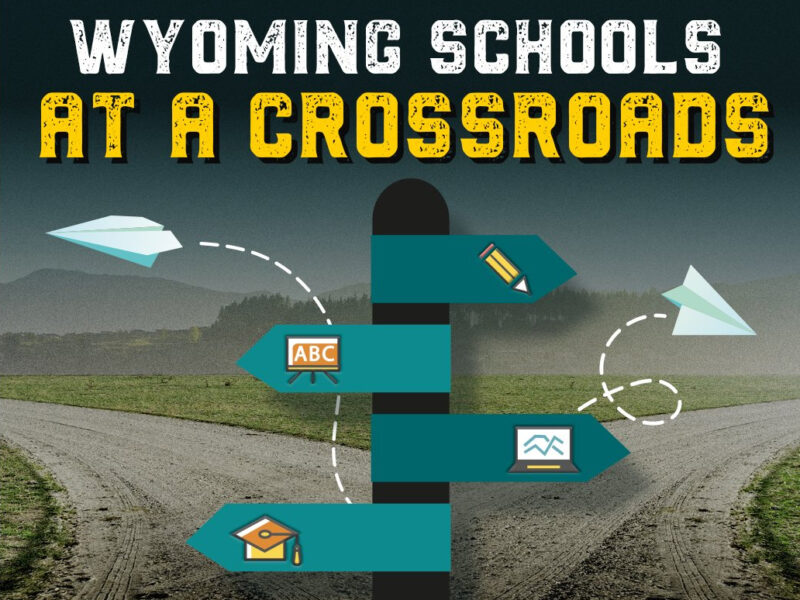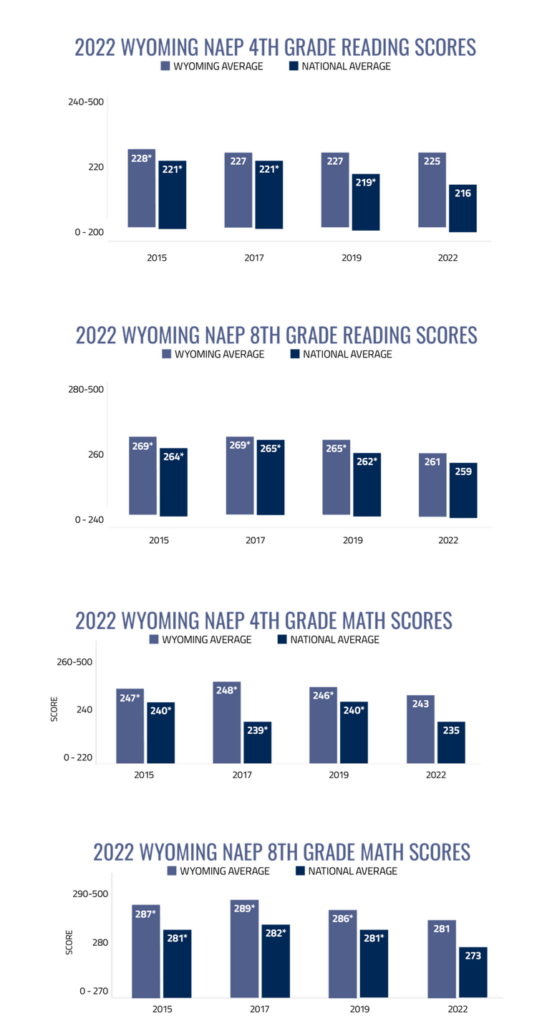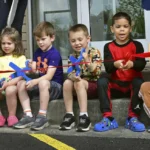WYOMING SCHOOLS AT A CROSSROADS: Teacher Endorses Public Funding for Preschool in Light of Declining Student Test Scores
Math and reading scores slip 1% to 2% for fourth and eighth graders in Wyoming, national assessment shows
- Published In: Other News & Features
- Last Updated: Nov 03, 2022

By Shen Wu Tan
Special to the Wyoming Truth
In response to declining student test scores, Green River elementary school teacher Brittney Montgomery wants Wyoming to provide free preschool for its young students as a way to prevent learning shortfalls.
“As a primary educator, I know the value and importance of creating the experiences needed to build foundational learning skills,” said Montgomery, who teaches first grade at Harrison Elementary School and was named Wyoming’s 2022 Teacher of the Year. “When I taught kindergarten, the discrepancy in educational experiences and learning exposure among students who attended preschool versus those who did not was noticeable.”
Average scores in Wyoming for eighth grade reading were lower than those reported in 2019, 261 this year compared to 265 three years ago, or a 1.5% decline, and lower in mathematics for both fourth and eighth grade students, data from the 2022 National Assessment of Educational Progress (NAEP) revealed. The report was released by the Wyoming Department of Education last week.
Eighth grade math scores dropped from 286 in 2019 to 281 this year, a 1.7% decline, while fourth grade math scores declined from 246 to 243, a 1.2% drop. Fourth grade reading scores dipped slightly since 2019, from 227 to 225 or a 0.88% decline. However, Wyoming scores for reading and math in both grades exceeded the national average scores.
“If our state provided preschool, we could close the gaps by supporting learning experiences and applying foundational skills,” Montgomery continued. “I caution that we also utilize preschool for exposure to developmentally appropriate content and experiences. Through purposeful play, developmentally appropriate content, hands-on application and real-world experiences, students are able to deeply connect to learning.”

The COVID-19 pandemic and student performance
Although Montgomery urged for an emphasis on preschool education, Linda Finnerty, a spokesperson for the Wyoming Department of Education, said that preschool learning does not fall under the agency’s purview, only kindergarten through 12th grade.
Chad Auer, deputy superintendent for the education department, noted although Wyoming saw declines in test scores, the state continued to “hold strong and even gain ground compared to other states.”
“The 2022 Wyoming NAEP results certainly show the impact of a challenging time in education,” Auer said.
He added he would like to see school districts use national and other assessments to evaluate their curricular and instructional programs and make adjustments.
“Wyoming’s teachers and principals are amazing professionals,” Auer said. “I have no doubt that they will continue to use data to improve how they lead Wyoming’s students forward.”
Several factors contributed to falling test scores, but the largest one is the pandemic, Auer speculated. Wyoming was one of the first states to return to in-person instruction, which “clearly helped our kids,” he noted.
The pandemic delayed the national assessments scheduled for 2021 until this year. Testing is administered in all 50 states, the District of Columbia and Department of Defense schools every two years in reading and math to fourth and eighth graders.
The drop in test scores in Wyoming reflects what is happening nationally in public schools.
In 49 states and the District of Columbia, eighth grade math scores fell since 2019 and eighth grade reading scores declined in 33 states, according to the assessment results. Meanwhile, fourth grade math scores dropped in 42 states, and fourth grade reading scores declined in 30 states.
When the pandemic hit, teaching and learning styles shifted, Montgomery said. Educators were asked to teach via computer—something many of them had never done.
“We did our very best, and so did our students,” Montgomery said. “That being said, we knew gaps were created, resources were not equitable, and it was truly survival mode. I think many forget or don’t think to consider what impact COVID had on students. They were sent home, isolated, and asked to take ownership of their learning without any modeling or practice. Imagine you are 6 years old and at school playing and learning alongside friends. The next thing you know, you are not able to return to school, and your learning is now all on you.”
Grady Hutcherson, president of the Wyoming Education Association, acknowledged the challenges both students and educators experienced during the COVID-19 pandemic, calling the state’s “relative stability” in national scores “a testament of their hard work and dedication.”
“Though Wyoming’s NAEP scores continue to be amongst the top in the nation, this year’s scores do illustrate a slight decline,” Hutcherson said. “We must remain vigilant in acknowledging and serving the changing needs of students and educators in the wake of the pandemic.”
Ways to revamp Wyoming’s education system
Since 2015, Wyoming scores have slipped across the board for fourth grade and eighth grade reading and math, but were “statistically flat” for fourth grade reading since 2017, the education department found.
Heather Fleming, a literacy expert who co-founded WY Lit, said she finds it odd that any Wyoming educational administrators, school boards or legislators would “celebrate Wyoming scores being near the top of a pile of national reading scores that are below proficient.”
“Wyoming has a tier 1 instructional problem in literacy that is the result of incomplete teacher and administrator preparation and licensure,” Fleming said. “It is unfair to ask teachers to spend their personal time re-learning what they were improperly taught in college. It is unfair to ask districts to fund professional development that should have happened in college.”
To reduce the cost of education, Wyoming’s state-funded teacher preparation program, particularly the literacy coursework, should be audited by external experts, she added.
State officials are considering a variety of ways to improve the education system. The State Board of Education passed a resolution in October that calls for an audit of state standards with the intent to clarify what Wyoming students need to know and should be able to do “to ultimately reflect what Wyoming has said it desires for its graduates,” said Diana Clapp, the board’s coordinator.
The board also has been developing the recently approved Profile of a Graduate to provide “an ideal vision” of a Wyoming graduate that can guide the state in education policy.
“It is important to the state board that their decisions reflect the vision the people of Wyoming have for a high school graduate,” Clapp said. “The board is currently having discussions about setting graduation standards. Having a clear understanding of a Wyoming high school graduate will inform the work of setting standards at each grade level.”
Additionally, the board is in the first phase of conducting a study that will evaluate the impact of accountability on improving school performance across the state.
Montgomery pointed out other efforts by the state to revamp student learning and improve reading skills. These include giving educators access to language essentials training, along with the department’s work on a literacy bill and its focus on student mental health and wellness.
She also cautioned against just measuring students and their academic progress by test scores.
“As we put on our curiosity lens and investigate data, it is important to remember data represents a human being, a student, a child,” Montgomery said. “These scores are only one piece of what a student is capable of. While the data is vital for instruction, intervention and enrichment, it isn’t the only information we need to truly know where a student is academically.”













